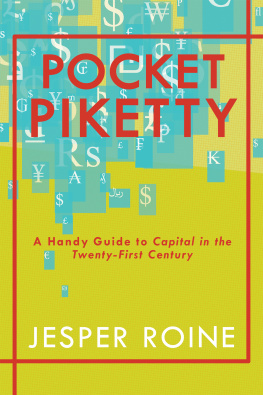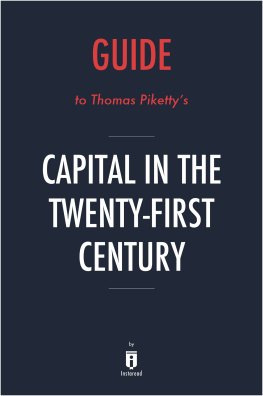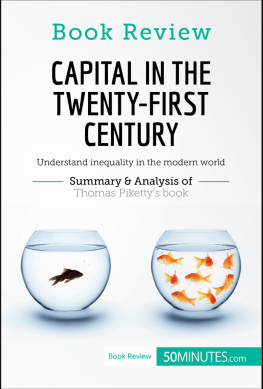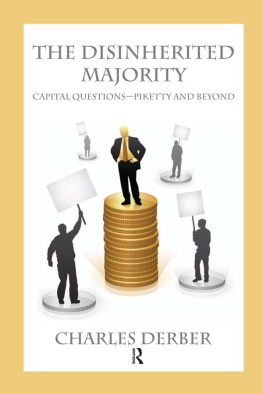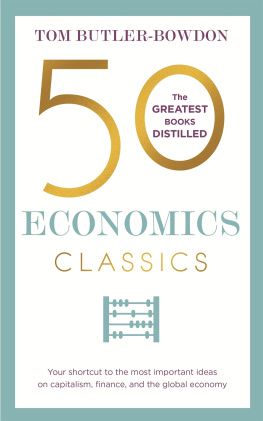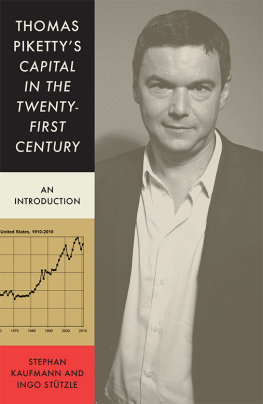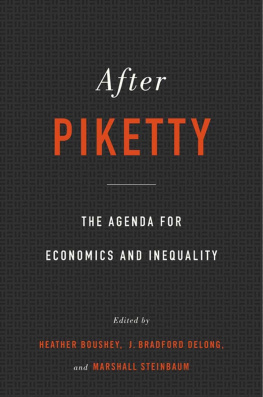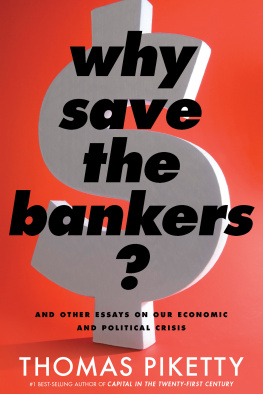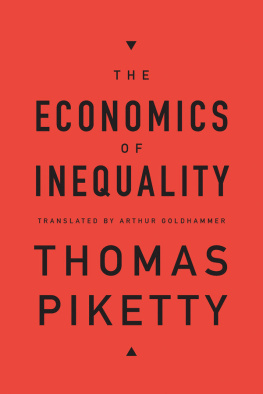


2017 Jesper Roine
Published for the book trade by OR Books in partnership with Counterpoint Press.
Distributed to the trade by Publishers Group West
All rights information: rights@orbooks.com
All rights reserved. No part of this book may be reproduced or transmitted in any form or by any means, electronic or mechanical, including photocopy, recording, or any information storage retrieval system, without permission in writing from the publisher, except brief passages for review purposes.
First printing 2017
Cataloging-in-Publication data is available from the Library of Congress.
A catalog record for this book is available from the British Library.
ISBN 978-1-944869-35-9
Text design by Under|Over. Typeset by AarkMany Media, Chennai, India.
10 9 8 7 6 5 4 3 2 1
CONTENTS
I
II
III
Preface
This book was originally written in Swedish in the spring of 2014, just after the English-language publication of Thomas Pikettys Capital in the Twenty-First Century . In Sweden, as in the United States and in many other countries, Pikettys book caused massive debate. Having worked on top income inequality, and being familiar with the book and the underlying research, I participated in this debate mainly by trying to correct views and statements that I thought were based on misunderstandings of what the book actually said. I also tried to provide background to the research underlying Pikettys book to explain why it was such an important achievement and to elucidate the different, often conflicting positions put forward by different commentators. Having noticed my activity, two friends suggested I put all this together into a short book, to give an introduction to all of those for whom the original text was too much. The idea was to make at least the basic facts and reasoning accessible to as many people as possible. The result was basically the book you are reading now.
Even if the discussions surrounding Thomas Pikettys book have calmed down and disappeared from the main headlines, they are by no means over. On the contrary: his work has given rise to a great number of research projects delving deeper into to different parts of his arguments. This work is ongoing and constantly evolving and will continue for a long time.
Had I been asked to introduce and summarize the book today, it is possible that I would have emphasized some things more, and others less, but essentially I think the introduction and the summary would not be much affected by the time that has passed. The final concluding part would perhaps have lengthened, due to the many additional topics that have been raised since the spring of 2014. Its main conclusions would remain unchanged.
Would I have written this book if asked today? I hope so. The original motivationto make it possible for as many people as possible to appreciate the importance of Capital in the Twenty-First Century and participate in the discussions it startedis still present. If anything, this feels even more important today than two years ago.
Jesper Roine
Stockholm, October 2016

Why all the fuss?
In spring 2014, Thomas Pikettys book Capital in the Twenty-First Century burst onto the world stage. It was suddenly everywhere, topping various bestseller lists and prompting reactions from all sorts of people, from Nobel laureates and other prominent academics to social commentators from different camps. Opinion remains divided. Some see the book as a watershed that fundamentally changes our understanding of how the economy works, while others challenge the premise of the book and question the data provided.
Personally, I found all the fuss a little surprising. The book first appeared in French back in 2013, and much of the book is based on research Thomas Piketty and others have been working on for over a decade. Many of the results concerning the historical trend of income and wealth flows have long been there for anyone to find.
As for my own background, I have been part of the research network that has spent the past decade or so identifying long-run historical series for income and wealth distribution in a host of countries. Together with Daniel Waldenstrm at Uppsala University, I produced the Swedish series for top income shares over the twentieth century as found in the World Top Income Database, which forms an important source in Pikettys book. Daniel and I also created a series for Swedish wealth concentration since the nineteenth century. Together with a number of colleagues (Anders Bjrklund, Henry Ohlsson and Jonas Vlachos) in various constellations, we wrote about specifically Swedish issues concerning income and wealth distribution and drew a range of international comparisons. Over the years, Daniel and I also published a number of articles on ekonomistas.se about this research.
On closer consideration, the attention Capital in the Twenty-First Century received is both understandable and deserved. Thomas Pikettys book is much more than a list of historical facts. It is an attempt, against a background of historical facts , to understand the underlying correlations and, based on this understanding, to consider what can be done about growing inequality in society. In a time when many international organizations such as the OECD and the International Monetary Fund are expressing concern about the trend and President Barack Obama called inequality the defining challenge of our time, it is hardly surprising a book claiming to explain how we got here and what should be done in the future has attracted such interest.
Why this book?
Does capitalism have a natural tendency to reinforce differences in peoples income and wealth? Or is it perhaps the other way aroundinitial differences become smaller as the economy develops? Perhaps this phenomenon has varied between societies, and over time. To what extent does the answer depend on the way the economy is organized? How do these economic relationships relate to our views on fairness and meritocracy?
Classic theories from Ricardo to Marx to Kuznets have all dealt with this broad subject: the relationship between economic growth and the distribution of the gains from this development within the population. This is also the focus of Thomas Pikettys book Capital in the Twenty-First Century . The big difference is, in contrast to its predecessors, Pikettys book is not just a theory about how the economy works, but a theory based on facts about income and wealth distribution over the entire twentieth century, and on the relationship between capital and income all the way back to the eighteenth century. The reason Thomas Piketty was the first to formulate a theory on the basis of such facts is that our knowledge of these conditions is largely new. Much of this new knowledge has come out of research to which Thomas Piketty devoted himself over the past fifteen years.
Increased knowledge does not automatically mean the theory presented by Thomas Piketty in his book must be true. As with all theories, his was based on assumptions open to debate and challenge. It is also possible that, like so many of his predecessors, he was wrong in his predictions about the futuresomething he repeatedly emphasizes in the book. This does not make Capital in the Twenty-First Century any less important and it certainly does not diminish his research contributions. We now know more about key relationships in the economy, and in particular much more about income and wealth distribution over time, than we did a decade ago, and much of this is thanks to Thomas Piketty.
Next page
